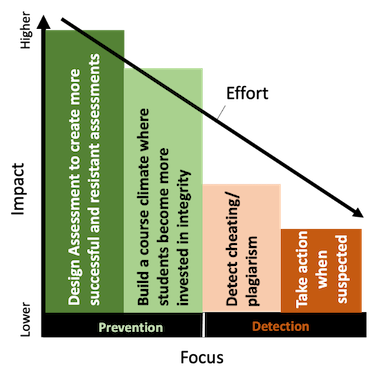Promoting Academic Integrity

Educators, colleges, and university processes all play a key role in helping students to both understand the concept of academic integrity and make the choice to act with integrity. Although detection activities increase integrity, designing resistant assessments, modeling, and teaching norms are more successful in reducing academic misconduct (Lang 2013). To effect a significant reduction in instances of academic misconduct, our efforts should be focused on prevention. Some students will engage in academic misconduct regardless of college or instructor actions, but we can still influence students who decide to cheat or plagiarize at the last minute.
Course design that promotes integrity should include two key categories of action: assessment design and classroom climate (including modeling and teaching).

Assessment Design
Assessment actions vary in complexity. You can have the most impact on academic misconduct through assessment approaches and design; least impactful are additional exam protections. However, all the listed actions will make a difference to the likelihood of academic misconduct, and you are advised to take a combination of actions that makes sense in your course. If you cannot take the most impactful actions, pick from alternatives. You can read more about design considerations for a remote context.

Re-design assessment approach
2. Scaffold assessments so that students are less likely to fall behind and become overwhelmed, making them more tempted to cheat.
- Allow students to practice forms of assessment and get feedback to clarify expectations;
- structure smaller assessments building up to a larger project;
- avoid tying a significant weight to a single assignment (i.e., high stakes).
Not sure about your best assessment options? Work through this short self-selection process to get advice.
Modify exam to open book
5. Create questions requiring higher level thinking, ideally within a context relevant to students’ futures or central to the discipline. Harder questions also allow you to test several things at once in ways that mimic disciplinary thinking, while reducing the total number of questions that need to be marked.
6. Specify what resources students can use, such as course materials, and which they cannot, such as online homework help sites. For information on how homework sites can be misused, see What is contract cheating? (Educatus, GMCTL Blog). Be explicit about whether students can work together (or with a campus academic supports). Alternatively, consider designing to allow for collaboration and acknowledgement of assistance.
7. Recommend the time to complete each question, and work through practice questions of similar type and complexity in class. When you change the type of question, students may not know how to answer it, even if they understand the content.
Add exam protections
9. Use testing banks in Canvas to vary the order of the questions and order of answers. Read about Canvas testing options, or watch a video on building test banks, which can randomize questions.
10. Avoid designing closed book exams that prevent students from going back to previous questions or getting a sense of how to budget time on an exam. While preventing students from going back may slightly reduce cheating, it also damages the accuracy of exam results for students who are maintaining academic integrity and trying to do well.
Additional considerations:
- Consider bandwidth and technical issues when designing closed book exams delivered over distance. You may need to allow additional time and will need to provide alternatives if students cannot access the exam.
- You can choose from numerous strategies and resources (videos, tip sheets) to help students prepare and develop exam skills, including for online and open book exams.
- Review this article Instructor Strategies to Mitigate Contract Cheating -Educatus, GMCTL Blog
Classroom Climate
Model and Teach Norms
2. Create cultural norms and expectations for academic integrity. Use these talking points to help frame your expectations and approach. Consider using the Academic Integrity Tutorial to explore the fundamental values of academic integrity with students. Model integrity by adding citations in your own slides and sourcing images.
3. Teach students about the USask policy, Student Academic Misconduct Regulations, and view more information and resources on remote teaching and copyright.
4. Be clear that academic integrity is important to you. For example, you might include an academic integrity declaration as a requirement, so students must think through their intentions and cannot be confused about your expectations. You can also offer resources such as the Academic Integrity Tutorial in your class to teach about integrity more overtly.
Communicate Overtly
6. Discuss cheating and plagiarism and what you do to detect it. Keep descriptions of detection processes general, but communicate it is likely you will notice academic misconduct and follow up directly to maintain fairness in assessment for all students.
7. If academic misconduct has been found, let your class know and share that it is being investigated, without disclosing specific details. Students otherwise committed to academic integrity can be swayed to cheat if they believe that everyone else is getting away with something, and that they are at a disadvantage.
8. Have a discussion with students about unintentional misconduct and how many students inadvertently cheat or plagiarize due to a lack of writing, study, and time-management skills. Encourage students to develop skills that help prevent misconduct through a range of workshops, resources, and services offered by Student Learning Services. You can also make students aware that "Contract Cheating is Riskier than Students Think" (Educatus, GMCTL blog).
9. Share the approach you have taken with students when you have questions about their work. If you paint a vivid picture of this, and are prepared to have conversations of this kind, it can help your students see follow up as a real possibility.
Additional articles and information regarding Contract Cheating can be found at Educatus, GMCTL blog.
References
Lang, J. (2013). Cheating Lessons: Learning from Academic Dishonesty. Harvard University Press, Cambridge, MA.